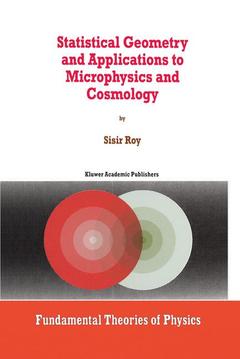Description
Statistical Geometry and Applications to Microphysics and Cosmology, 1998
Fundamental Theories of Physics Series, Vol. 92
Author: Roy S.
Language: English
Subject for Statistical Geometry and Applications to Microphysics...:
Keywords
Publication date: 10-2012
251 p. · 16x24 cm · Paperback
251 p. · 16x24 cm · Paperback
Description
/li>Contents
/li>Comment
/li>
Recent results from high-energy scattering and theoretical developments of string theory require a change in our understanding of the basic structure of space-time. This book is about the advancement of ideas on the stochastic nature of space-time from the 1930s onward. In particular, the author promotes the concept of space as a set of hazy lumps, first introduced by Karl Menger, and constructs a novel framework for statistical behaviour at the microlevel. The various chapters address topics such as space-time fluctuation and random potential, non-local fields, and the origin of stochasticity. Implications in astro-particle physics and cosmology are also explored.
Audience: This volume will be of interest to physicists, chemists and mathematicians involved in particle physics, astrophysics and cosmology.
Audience: This volume will be of interest to physicists, chemists and mathematicians involved in particle physics, astrophysics and cosmology.
Preface. 1. Introduction and Historical Survey. 2. Statistical Behavior of Microparticles. 3. Space-Time Fluctuation and Random Potential. 4. Non-Local Fields. 5. Astro-Particle Physics. 6. Einstein Equation for Gravitational Field. 7. Origin of Stochasticity. 8. Possible Implications. 9. Epilogue: New Dialogue of Man with Nature. Bibliography. Index.
Recent results from high-energy scattering and theoretical developments of string theory require a change in our understanding of the basic structure of space-time. This book is about the advancement of ideas on the stochastic nature of space-time from the 1930s onward. In particular, the author promotes the concept of space as a set of hazy lumps, first introduced by Karl Menger, and constructs a novel framework for statistical behaviour at the microlevel. The various chapters address topics such as space-time fluctuation and random potential, non-local fields, and the origin of stochasticity. Implications in astro-particle physics and cosmology are also explored. Audience: This volume will be of interest to physicists, chemists and mathematicians involved in particle physics, astrophysi
© 2024 LAVOISIER S.A.S.
These books may interest you

Neutrino Cosmology 88.35 €



